Find out the ideal procurement strategy for your business.
Accounting professionals don't have to be procurement experts, but it's helpful to know some procurement basics that impact profitability when your company is buying new products and services to run the business.
The concepts of source-to-pay and procure-to-pay should be high on your to-learn list since they involve both supply chain principles and accounts payable processes. The more you know about each approach, the better you can advise decision-makers on which one might make more financial sense for your firm.
In this blog, we'll cover these concepts with insights from Ravi Nishant[1], a seasoned procurement specialist who has managed suppliers in multiple industries, and research from Gartner.[2]
What are source-to-pay and procure-to-pay?
Source-to-pay and procure-to-pay are two approaches to standardize goods and service acquisition for a business, whether cement for a construction company or drugs for a pharmaceutical business. Here’s how they do it.
Source-to-pay (S2P) begins at the source—finding the required materials and locating suppliers. It covers the entire purchase journey from identifying what you need, finding the right supplier, negotiating terms, creating contracts, placing orders, and receiving the goods or services, to finally making payment.
Procure-to-pay (P2P) is one part of the S2P strategy that focuses on the purchasing side of things. It kicks in when you’ve already identified suppliers and you need a consistent and uniform way of transacting with your preferred suppliers. It includes recognizing what you need, selecting from a list of pre-approved suppliers, submitting a purchase requisition for desired goods or services, creating a purchase order (PO), and paying suppliers.
Businesses use procurement tech stacks built on S2P or P2P models to implement these approaches. Depending on their need, they either opt for full-suite S2P solutions or choose software with only the P2P functionality.
Let's simplify this further, using an analogy
If you were to order a meal for your lunch, using S2P would be like researching different restaurants to find the best food and prices, and then talking to the staff to customize the meal for your dietary preferences before placing the order.
P2P, on the other hand, is like going to your regular fast-food joint, getting a customized sandwich you always order, and paying for the meal without any explanation.
"Both methods enhance efficiency by removing arbitrary purchases from unverified sources. S2P gives you a clear audit trail, from finding suppliers to comparing rates and generating POs. P2P guarantees you only work with contracted and compliant suppliers."


Ravi Nishant
Certified purchasing professional (CPP), Project procurement specialist
Key differences between S2P and P2P
Both approaches serve different purposes and provide different benefits.

S2P covers the end-to-end procurement process, from sourcing suppliers and negotiating contracts to managing relationships. The P2P process focuses only on specific purchasing activities, including requesting, ordering, receiving, and paying.
S2P takes a big-picture approach, emphasizing strategic sourcing and the value of long-term supplier relationships. The P2P process prioritizes cost savings and getting things done quickly.
S2P involves cross-functional teamwork requiring multiple units to work together to ensure the right products and services are procured. The P2P process is department-focused, where specific teams request items and are responsible for procurement.
Do you need S2P or P2P approach to procurement?
According to Nishant, businesses of all sizes, in all industries need S2P and P2P solutions.
“Whether you’re in a services setup working with an IT maintenance provider, or a manufacturer seeking raw material at affordable prices, you need to track your current spending patterns and identify suppliers bringing the most profit to your business to identify cost-saving opportunities and build strong relationships with the right people.”
Ravi Nishant
By using P2P and S2P, you:
Make sure your teams work with reliable suppliers who have valid credentials (say a registered company) and comply with industry regulations.
Streamline payments by processing invoices in a jiffy. These systems automatically authenticate the service or goods receipts from suppliers and ensure payments are made on time.
Forge long-term strategic partnerships with suppliers, leading to better deals, more discounts, and lower prices.
Get priority service and strong support from suppliers by earning their goodwill.
Make smart investments and cost-saving decisions by monitoring your spending and the most profitable suppliers with spend analytics.
Key business processes supported by P2P and S2P
P2P technology, at the very least, supports online purchasing and invoice processing. Not all procurement solutions cover payment processing though. S2P suites include P2P capabilities plus sourcing, analytics, and contract management.
Procure-to-pay solutions are foundational for all procurement technologies, but buyers are increasingly asking for full-suite S2P software that digitizes end-to-end processes. A Gartner survey reveals that over 50% of procurement officials have digitized the entire sourcing and procurement of goods and services in their business.[2]

Procure-to-pay solutions
e-Purchasing: Shop online with your company’s approved supplier network, submit a purchase request for approval, get it approved using a predefined workflow, and generate a purchase order (PO) for suppliers.
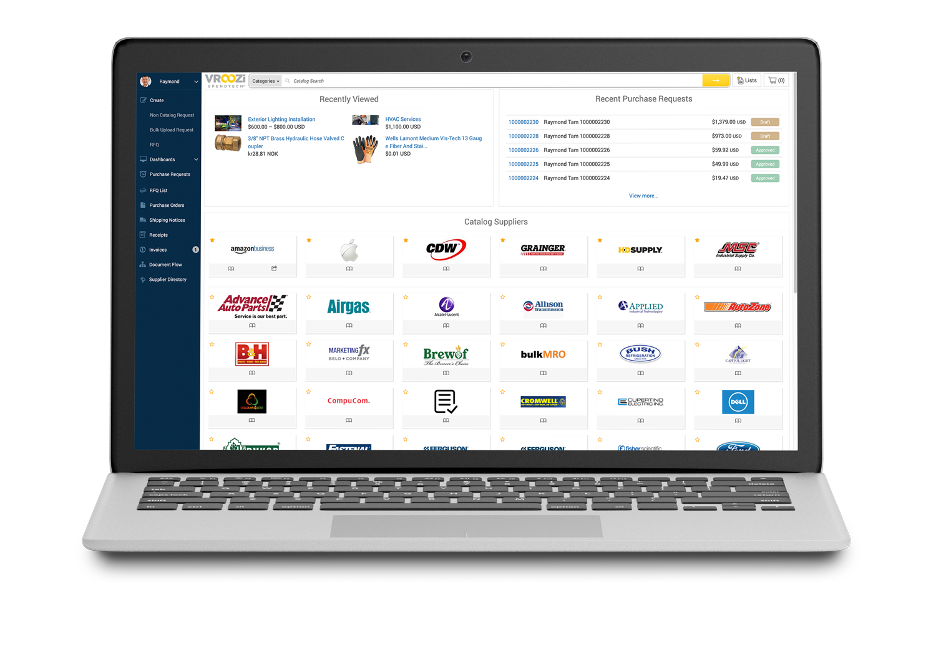
Example of an online catalog of approved suppliers (Source)
Accounts payable automation: Make invoice processing simple by automatically capturing details from supplier invoices, matching them against your POs or using pre-defined approval workflow when no PO exists, and finalizing payments if both match. Handle exceptions on vendor invoices such as transportation costs or taxes easily and send invoice acceptance status and remittance updates to suppliers.
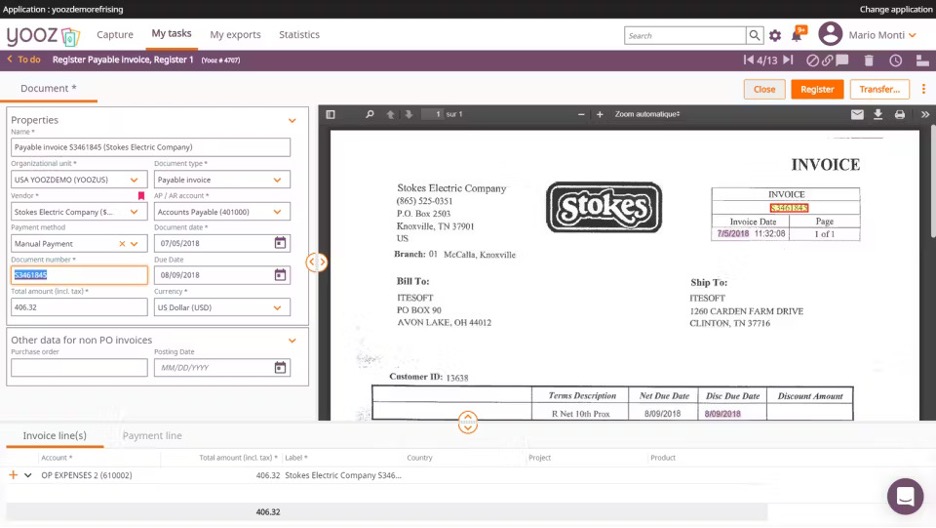
Example of invoice capturing (Source)
Payment: Use various methods to pay your suppliers easily. All P2P solutions don’t offer payment processing functionality. Many businesses deploy specialty payment processing solutions and integrate them with the P2P system for security reasons.
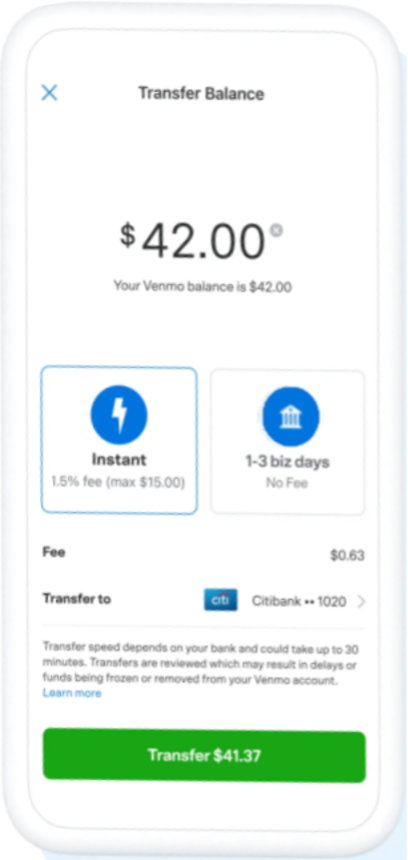
Online payment processing example (Source)
Source-to-pay solutions
e-Sourcing: Get access to a digital marketplace to find and connect with new suppliers and send requests for proposals to the ones you would like to work with. Take their quotations, compare their prices, and finalize a supplier.
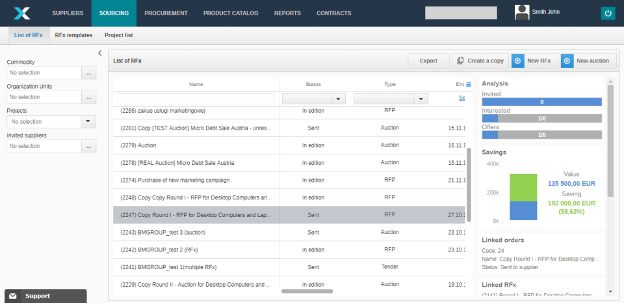
Example of online sourcing (Source)
Spend analytics: Know where your money is going with powerful insights on spending patterns and find ways to save and make better financial decisions. Nishant insists that even if you’re opting only for a P2P solution, make sure it has a feature to synthesize spending data and provide reports: “This data works wonders in controlling expenses.”
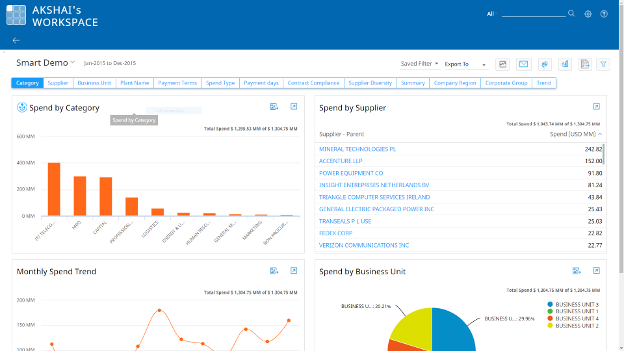
Spend analytics dashboard example (Source)
Contract management: Streamline contract management, from creation to execution and renewal or termination. Get pre-filled templates created as per regional legal requirements to make airtight contracts. Many businesses deploy a contract management tool as a specialty solution and integrate it with their existing procurement software stack.
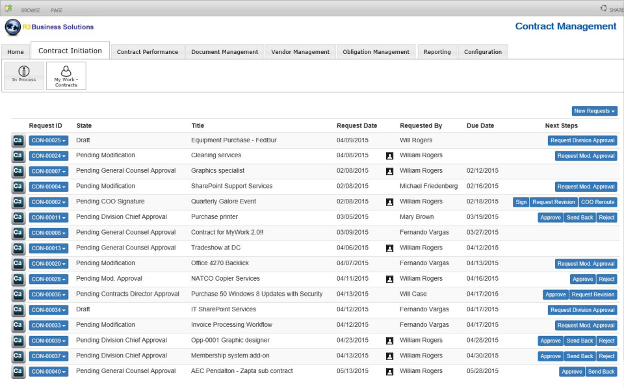
Contract management solution example (Source)
Selecting the right procurement approach: A two-step test
To decide which procurement strategy is a good choice for you, Nishant suggests taking two tests.
#1. Classify your suppliers
“Separate your suppliers into strategic, tactical, and one-off categories, and analyze your spend on each.”
Ravi Nishant
Strategic vendors are suppliers who help you get essential raw materials and services, which are critical for your business. Tactical vendors are those you contact when an immediate need arises from a stakeholder or in case of an emergency. Their focus is on speed rather than getting bogged down in the organizational sourcing process. One-off vendors are for special needs, whom you call once or twice a year for consultation, such as a quality analyst.
Once you’ve divided your suppliers into these three categories, use the guide below by Nishant to determine the best-fit procurement approach for you.
If most of your spending goes to your strategic vendors, you’re good. Stick with your current vendors, and simplify the purchase process with a P2P solution.
If your spending is going to multiple strategic vendors with short-term contracts that require frequent negotiations, consider using an S2P solution for better supplier management. It’ll help you consolidate purchases with a single vendor, and take advantage of better-negotiated pricing based on contract length and purchasing volume.
If you’re spending more on tactical and one-off vendors, you need better strategic vendors who can help you even with occasional tactical and one-off needs: “Ideally, you should try to fulfill and channelize most of your demands through your strategic vendors.” Use S2P solutions to diversify your dealer base and forge better supplier relations.
#2. Consider your sector
Factor in the nature of the materials you deal with and the competitiveness of your industry.
Specialty materials, such as coal, stones, or chemicals, require authorized dealers. S2P solutions can help you diversify your suppliers and source cost-effective and valid dealers from across the world: “Sourcing such materials from outside your country can sometimes prove a lot cheaper than in your own country, in spite of custom duty and other charges.”
If you work in a competitive industry such as IT, which is constantly changing, an S2P solution can help you change suppliers swiftly and always operate at the best prices.
If you’re in a business that operates with readily available materials, such as healthcare or retail, you likely have regular suppliers that you hardly change. In this case, a P2P solution can be sufficient to simplify procurement and transactions.
Watch this video to learn three tips on choosing the right procurement approach for your business.
Now that you know the differences between S2P and P2P procurement approaches, you can see how using them in business builds a strong supplier network, leading to fruitful relationships with trusted dealers and enhancing your overall profits with more discount offers.
Let’s summarize what we learned in a few takeaways.

Regardless of your chosen approach, request a demo or free trial to see if a procurement solution fits your needs. For more guidance, check out our procurement software buyers guide for detailed information on key features you should look for.
